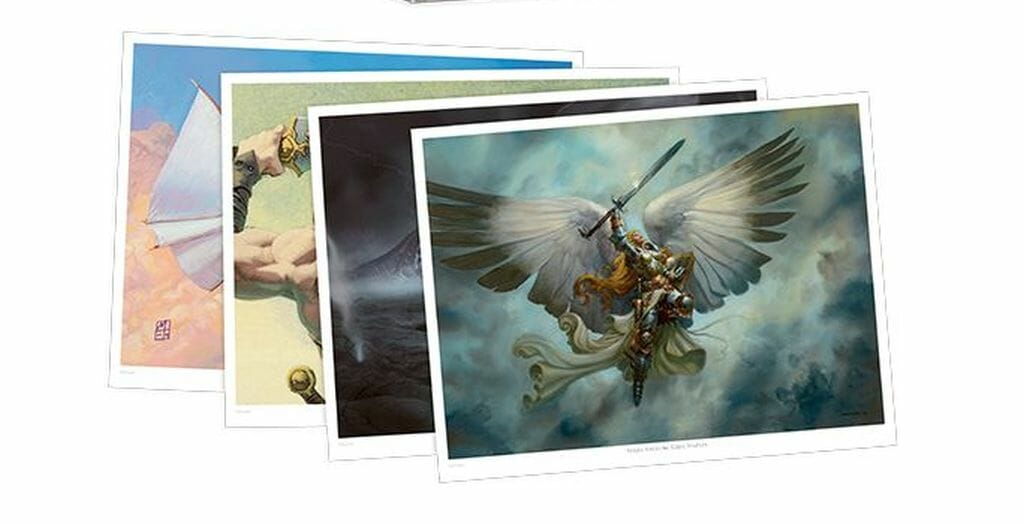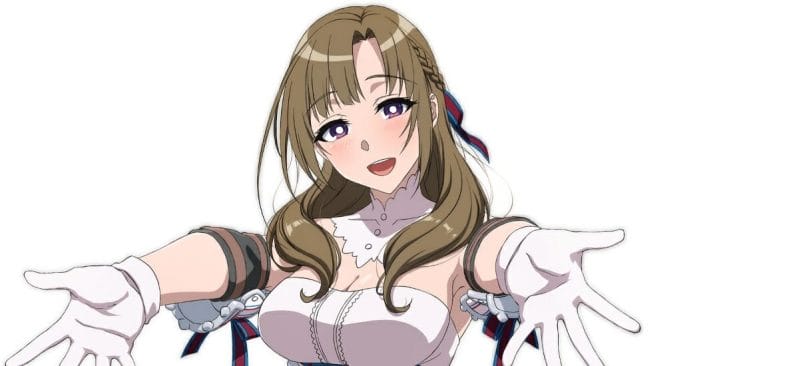Author: Wizards of the Coast
US Publisher: Viz Media
 When The Art of Magic: The Gathering: Ravnica is released on New Year’s Day, Viz will have published eight Magic: The Gathering art books. Seven are plane-specific:
When The Art of Magic: The Gathering: Ravnica is released on New Year’s Day, Viz will have published eight Magic: The Gathering art books. Seven are plane-specific:
You can find my Ixalan review here. The Art of Magic: The Gathering: Concepts & Legends is a bit different. Unlike the plane-specific books, it covers the whole of Magic history.
The foreword from Matt Cavotta tells us what to expect from this 25th anniversary art book, but your eyes will be drawn to the enormous image of Emrakul, the Promised End (Jonas de Rio) that spans all of page four, and a significant portion of page five. Trust me, she’s worthy of the space.
Nicol Bolas is not one to be outdone, so we get a similarly sized image of him on pages eight and nine, from Hour of Devastation (Simon Dominic).
As the original plane of Magic: The Gathering, Dominaria gets first billing on pages 10-17. We get both the story about how Dominaria effectively hosted the first decade of Magic: The Gathering, as well as its rebirth in the storyline. Page 15 is stunning (no spoilers this time).
Next up is Karn’s creation, Mirrodin. The metallic plane spans pages 18-23. The highlight here is the concept art for the creators of New Phyrexia.
Kamigawa comes next ,in pages 24-27. Kamigawa was the first Magic: The Gathering plane to be inspired by a specific real world place (Japan) and its mythology.
Dominaria can claim to be an heir to the legacy of Dungeons and Dragons, as well as the spirit of countless fantasy novels. Mirrodin was a unique creation. Kamigawa was different, in that it was the first plane to have a focus on legendary creatures. Perhaps, one day, Kamigawa will get its own plane-specific art book.
Next up is Ravnica, which covers pages 28 and 29. The city of Ravnica covers the entire plane, which provided a unique challenge to the artists. No mountains for Red, no seas for Blue. The swamps have been drained, the plains have been paved over… and let’s not talk about the forests. (sad face)
Lorwyn and Shadowmoor cover pages 30 and 31. Oona rules here, and we see the same plane in different forms as she sees fit.
Alara is on pages 32 and 33. For me, the highlight of these two segments was the concept sketch for Naya on the bottom-left of page 30.
Zendikar covers pages 34-37. The image that spans page 34 and a portion of page 35 tells the story quite succinctly: The people are small. The world is large.
The gothic Innistrad covers pages 38-41. The concept image of a werewolf’s breath in the cold is gorgeous.
The Greek-inspired Theros covers pages 42-45. The art of the gods of Theros is some of the best work in the history of Magic: The Gathering:
Tarkir covers pages 46-49. The highlight in this section is the full-page of Sultai Ascendancy (Karl Kopinski) on page 49.
The color palette of Kaladesh on pages 50-53 is a stark contrast to the planes that came before.
During a tour of Wizards of the Coast, I was able to see art from Amonkhet before it was released. The Egyptian plane meets its end at the hands of the powerful dragon-planeswalker. We get to see the good times, as well as the various races on pages 54-57.
Ixalan is our final plane, covering pages 59-64. The vampire conquistadors, pirates, merfolk, and dinosaurs are on full display.
Pages 65 and 66 list some of the more common races of Magic: The Gathering, while pages 67 and 68 discuss the color identity and the color wheel itself. Next up are the various races and their original concept art:
- Catfolk (pages 68-71)
- Aven (Pages 72-75)
- Kor (pages 76-77)
- Dwarves (pages 78-79. Note the goblin-like duergar on page 78.)
- Merfolk (pages 80-83. Here we get some of their concept notes.)
- Vedalken (pages 84-85)
- Vampires (pages 86-89.)
- Goblins (pages 90-93)
- Orcs (pages 94-95)
- Elves (pages 96-99)
The elves continue with a section on reinventing Llanowar on pages 100-103. The view of Llanowar on pages 102-103 is beautiful.
After the races of Magic, we get the creatures of Magic:
- Angels (pages 108-111. We get a full page (and then some) view of Serra Angel by Greg Staples on pages 108-109.)
- Reinventing Serra (pages 112-115. Here you will learn about The Church of Serra.)
- White Creatures (pages 116-119. We get Felidars, rhinos, dinosaurs, house cats, eagles, lions, griffins, pegasi, gryffs, and what I will swear is a parrot bred with a cheetah.)
- Sphynxes (pages 120-125. Sphinx of Uthuun be Kekai Kotaki gets the full page+ treatment here.)
- Blue Creatures (pages 126-129. We get drakes, djinn, fish, serpents, whales, kraken, and leviathans.)
- Demons (pages 130-135. Wizards of the Coast had to deal with a lot of bad press early Magic’s history when religious groups complained about “Satanic imagery.” Thankfully the game survived. Page 132 has a slew of interesting takes on the subject.)
- Black creatures (pages 136-139. Zombies, skeletons, mummies, and scorpions are well represented.)
- HERE BE DRAGONS! (Pages 140-145. For no reason whatsoever, let me recommend The Great Zoo of China.)
- Red Creatures (pages 146-149. Giants, minotaurs, ogres, devils, hellions, fire elementals, manticores, warriors, and dinosaurs.)
- Hydras (pages 150-155. This is my favorite section of the book. What can I say, I like multiple heads.)
- Green Creatures (Wurms, behemoths, brushstriders, dinosaurs, boars, and baloths.)
We get to see various elementals on pages 160-161. Artifact creatures, such as the Myr are covered on pages 162-165. Then we come to the various characters from the history of Magic: The Gathering. The planeswalkers of old, such as Freyalise, Karn, Serra, and Urza are represented on pages 170-171. We return to the Weatherlight on pages 172-175. The Gatewatch are covered on pages 176-181. Finally, we close with the most recent generation of planeswalkers, such as Narset, Kaya, Dovin Baan, Huatli, Ashiok, Ugin, Ob Nixilis (in both human and demon form), Nicol Bolas, Sarkhan Vol, Tezzeret, and Vivien Reid (for whom we get a full spread with backstory).
Additionally, The Art of Magic: The Gathering: Concepts & Legends comes with double-sided prints of:
- Serra Angel (by Greg Staples, and by Donato Giancola)
- Llanowar Elves (by Kev Walker, and by Chris Rahn)
- The Weatherlight (by James Jones), and The Skyship Weatherlight (by Mark Tedin)
- Urborg, Tomb of Yawgmoth (by John Avon), and Cabal Stronghold (by Dimitar Marinski)
The one thing I feel compelled to note is that, due to rights issues, art from the original sets is not available here. Instead, we get the updated versions iconic creatures such as Serra Angel, Sengir Vampire, and Shivan Dragon. Given the sheer amount of concept art we’re given, it’s not a big deal. Still, I want to avoid any confusion on that issue. This book, like the entirety of the Viz Media’s Magic: The Gathering art book series, is as good as they can make it. James Wyatt is pouring his heart and soul into these and it shows.









